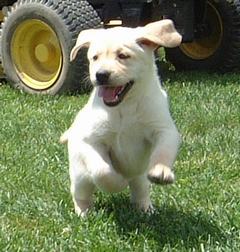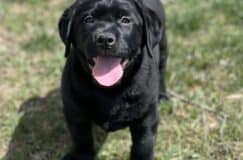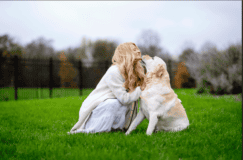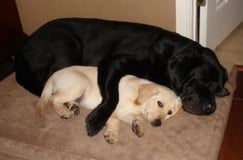Labrador Crate-Training Manual
Endless Mountain Labradors – Labrador Crate Training Manual

“the best way to house-break”
By Liz Palika
Adding a puppy to the household can be a wonderful experience, but the relationship can sour before it even begins if the puppy is ruining carpets and chewing up furniture. There is, however, a training tool that will enable you to train your new companion and avoid disaster—–a crate!
Two types of crates are available. The first type is often made of heavy molded plastic or fiberglass and is used by airlines to transport animals. Plastic crates usually come in two parts, top and bottom, and are easy to disassemble and clean. Wire crates, which provide better ventilation, are also available , but they do not provide the privacy and seclusion puppies need when they retreat to their crates for naps. However, a cover placed over a wire crate works if privacy is needed over circulation. Do not keep a pup’s collar on when placing him in a wire crate, it can catch on the wires when they jump around and there is a danger of strangulation.
Its important that you , the new owner, understand that the crate is not a cage or jail. A crate is your puppy’s own place—it provides them their natural “den” or bed, a place to hide special toys or bones and a refuge from times of stress.
Puppies like to sleep in small, close places. That’s why they curl up under the bed or under a chair, or crawl under the back porch. A crate allows you to use this instinct as a training tool. Begin by choosing a crate size to suit your dog. A large crate to fit your full-size dog is fine if you don’t want a small crate and then another later, but section it off (with boxes or something) to a space that fits your pup enough for it to stand up, stretch, turn around, and lie down comfortable. The idea is you don’t want the pup to sleep in one end and have room to relieve itself in the other…the purpose behind using this crate is to house-train the pup utilizing his instinct to keep his bed clean. He may have one or two accidents, but that will be all!
Introducing the Crate
Introduce your pup to the crate by tossing a treat inside while the pup is watching. Say, “(Name), crate!” and urge the puppy inside. Let the pup grab the treat and come back out. Repeat the action a couple of times; later place the puppy’s dinner inside the crate. Let the puppy eat with the door open, coming and going as it pleases.
When the pup is comfortable going in and out, toss a treat inside the crate, close the door after the pup goes inside. Wait a couple minutes, then open the door. Gradually increase time until the puppy is comfortable with the door being closed.
If your pup throws a temper tantrum when you close the door, do not let the pup out until it is quiet. If you let the pup out when it screams, it will have learned temper tantrums work. Instead, tell the pup, “NO! Quiet!” in a sharp tone of voice.
Put the crate in your bedroom at night so the pup can feel your presence and be reassured that you are near. It is eight hours that the pup can be near you even though you are sleeping. If the pup is restless, you will be able to hear it and take it outside. If the pup decides it wants to play, just reach over, tap the crate and say, “No! Quiet!”
During the day, place the crate near people, in the family room or kitchen. Let your pup see and hear the normal sights and sounds of the household.
When house training a pup, set up a schedule for the pup’s meals, playtime, crate time, trips outside, and follow it closely. The pup should be taken out to eliminate after waking, after eating, and after playing and about every 3 hours in between.
If you are a working dog owner, don’t plan on leaving the pup alone in its crate from 9-6 p.m.. That is entirely too long for the pup to be crated. Confine the pup with its crate to an easy-to-clean area (kitchen/bathroom/laundry room) or hire a neighbor to come play with the pup and take it outside.
If you are at home while housebreaking, feed pup 3 times a day knowing that potty time will be predictable right after, or within 5 minutes of eating/drinking. If you work, feed pup in the morning, allowing potty time before you leave, and when you return from work.
Preventing Problems
Puppies don’t intentionally get into trouble: its just that our belongings are so alluring, at least in a pups eyes. After all, a couch cushion that has been slightly chewed is a lot of fun when its shaken and the stuffing flies out! Leather shoes and rawhide chews are very similar to many pups!
Many of the destructive things pups do can be prevented by using a crate…they cannot destroy $100 shoes if crated when not supervised. By preventing these problems, you will establish good habits. The pup learns to chew on toys you give it, to sleep and be quiet, rather than learn to be destructive.
Security
A crate provides the pup/dog with security away from home. If needed to be boarded, send it with its crate. Use at hotels or when flying. Also, teaching the pup to ride in the crate in the car may save its life from being thrown from a car someday. It also stops interference with the driver.
As an Adult
As your dog matures, it can be given more freedom, but if it does make a mistake, crate it again. The dog must prove reliability by not chewing and having accidents. Too much freedom too soon will result in problems.
Your dog will still use its crate on its own if it has been used properly, as it provides its special place to sleep or to retreat when needed. Your dog will go there when low or sick. It will hide bones there to keep them away from the new baby or puppy in its new crate.
*****first thing in morning, pick up pup, take outside to a predetermined place, mark it, take pup back there always to trigger the idea of where to eliminate.. If you hurry, he will be more apt to do his job in a rush. Bring him inside to a small area where you will be. Around noon, let him out to run, after eliminating, bring into house for an hour or two of “confined freedom” with you. Take out again for quickie before putting back in crate. Just before dinner, take dog out to run, bring in for more “confined freedom”. Feed dinner, not later than 6:00 p.m., take outside again after dinner. Bring in for “controlled freedom” with you, taking outside again about 8 p.m., then again before retiring.
After about 2 weeks of this sort of routine, the pattern should be set, and you can allow more freedom as puppy becomes more trust worthy…and his bladder grows! (allowing for more freedom)
Bad, unruly dogs are almost always the result of lack of training or inconsistency, neglect, or abuse on the owners part. In as little as 5-10 min per day, you can have a well-behaved, happy dog that the whole family friends, and relatives can enjoy.
A sharp, loud “no” is sufficient reprimand for a puppy. The dog wants to please you. You can also grab pup by scruff of neck and look them in the eye to reprimmand (as an alpha bitch would do to it in the wild) It also establishes you as the “leader of the pack”…use a warm happy voice to praise puppy when he does well. NEVER USE HARSH DISCIPLINE…DON’T BORDER ON MISHANDLING OR ABUSING YOUR DOG!!
If you are unable to be gently and firm and patient with your pet, find another home for it before you give up, abuse, or neglect it. Be wise, and kind.
Never create a “live-wire” puppy by always playing rough, it is important to teach him to enjoy calm, quiet affection. Use this method with a soft soothing voice often. Limit the amount that children “rough house” with your pup!
[youtube width=”1000″ height=”688″]https://www.youtube.com/watch?v=hKBFkY_E2M4[/youtube]








9 Comments